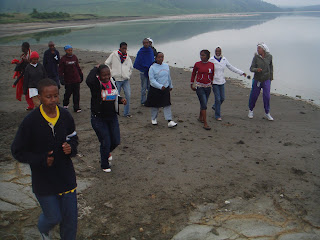Tuesday, May 11, 2010
YOUTH ON THE MOVE TO REACH FURTHER IN ENVIRONMENT CONSERVATION
Monday, May 10, 2010
Serving One Another

Within the Kenya Red Cross, the terms ` youth` and `young people` cover the broad age range of between 7 to 30 years.This includes children of between 7 t0 13 years old, adolescents of between 14 to 17 years old and young adults of between 18 to 30 years.

Traditionally, children and youth have tended to be the `beneficiary` of the movement, but through time they have proved instrumental to serve the movement as volunteers and partners in its management and governance.
Kenya Red cross believes in supporting and enhancing a unique, dynamic and capable Youth Volunteer force, while striving to continue being the leading humanitarian organization offering neutral and voluntary assistance to the most vulnerable in Kenya.
Youth Promise
To join with others all over the world and to help the sick and suffering.
These are; promotion of life and Health, community service, promotion of International Friends and Understanding, and Dissemination of Red Cross knowledge, values and International Humanitarian Law.
The youth programme aims at involving young people in the movement and its activities as partners, workers and beneficiaries. The work carried out in each of these areas depends on the challenges and / or needs faced by communities and the youth.

-HIV/AIDS awareness campaigns
- Blood donation mobilization
-First Aid training
-Drugs and substance abuse training
-Disease prevention and control campaigns e.g
measles, polio, malaria etc.
-Disaster preparedness and response e.g Assessments,
relief distribution, disaster management training.

2) Community service
-Environmental awareness campaigns e.g tree
planting
-Hospital visits
-Visits to the less privileged i.e. orphans, aged etc.
-Clean -up campaigns
.

-Encourage more support from friends, well -wishers and the general public.
-Attract young people 's membership to the Red Cross and Red Crescent.
key areas under dissemination includes;
- International Humanitarian Law
-The 7 Fundamental principles
-Mandate and values of Kenya Red Cross
-Components of the Kenya Red Cross
-Emblem use and abuse

4) Promotion of National And International Friendship And Understanding
Aim - Encourage friendship and networking amongst, young people at the local, regional and international level.
Promote cross cultural learning and experience sharing, at the local, regional and international level, through;
- Camp and crafts survival
-Mountaineering and networking
-Picnics
-Youth exchange programmes
-Youth conferences and workshops
-Team building initiatives
-Edutainment i.e. theatre, plays, music
-Youth Delegate/Exchange programmes
Membership
Membership to Kenya Red Cross is open to all regardless of class, race, gender, tribe, religion, political ideologies, age and nationality. The broad youth membership category may be classified under: a) Youths in school(Junior Red Cross)
- Primary
- Secondary
- College and universities
- Employed

Young people are welcome to Kenya Red Cross as volunteer to assist in time of need. Anyone can and may join as a volunteer. Youth forms a substantial part of the Kenya Red Cross membership, currently composing over 60 percent of the entire volunteer force. This vital constituency of the Kenya Red Cross needs an elaborate structure with well defined and functional levels through which youths issues can be articulated in the furtherance of the core four part youth objectives
Monday, April 5, 2010
A volunteer
A volunteer is one who, without pay, reaches out beyond the confines of his/her normal responsibilities, to freely and willingly carry out relevant tasks of the KRCS with the ultimate aim of achieving the stipulated objectives of the National Society. These tasks may be performed either regularly or occasionally, whenever the need arises.
Volunteering in the KRCS
Volunteering is the backbone,and the heart of the society's work
Volunteering, within the Society is an activity that is:
Motivated by the free will of the person volunteering, and not by a desire for material or financial gain or by external social, economic or political pressure.
Intended to benefit vulnerable people and their communities in accordance with the Fundamental Principles of the Movement.
Organized by recognized representatives of the Society.
Member as a Volunteer
Within the Society a person can have the legal status as a member, and at the same time be involved in an activity as a volunteer. Not all Members of the Society are volunteers and neither are all Volunteers of the Society Members. The choice is left to the person as to the amount of involvement that they will have within the Society.





